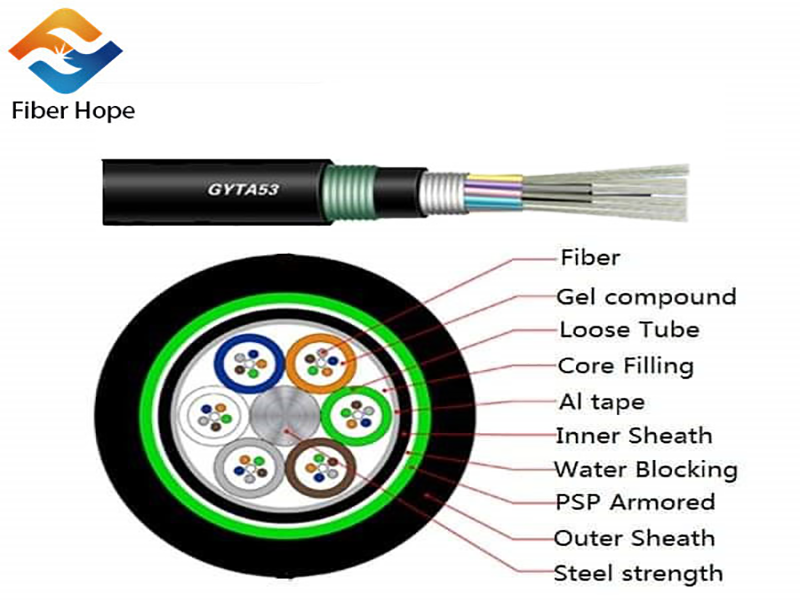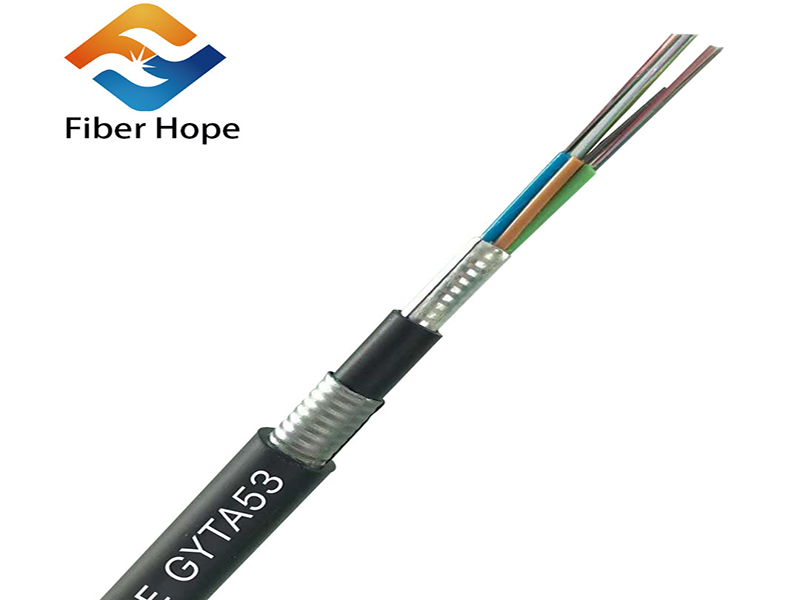Fiber Hope Optical Communication Tech Co.,Ltd.
E-mail:kevin@fh-fiber.com
Fiber Hope optical fiber communication expert & fiber optic cable manufacturer
E-mail:kevin@fh-fiber.com
Fiber Hope optical fiber communication expert & fiber optic cable manufacturer
1. Types and specifications of optical fiber
(1) Fiber type/category:
Fiber is mainly divided into two categories, with three classification methods.
1) Classification of transmission mode (transmission point modulus) of light in optical fiber:
Divided into Single Mode Fiber and Multi Mode Fiber.
Single -mode fiber:
The central glass core is thinner (the core diameter is generally 9 or 10 μm), and only one mode of light can be passed. Therefore, the color of the models is very small and suitable for remote communication, but its color color scattered the main role. In this way, the single -mode fiber has high requirements for the width and stability of the light source. Essence
The diameter of the core of the single -mode fiber is very small. In the given working wavelength, it can only be transmitted in a single mode, the transmission frequency bandwidth, and the transmission capacity is large.
Multi -mode fiber:
The central glass core is thicker (50 or 62.5 μm), which can pass the light of various modes. However, the color scattered between its models is large, which limits the frequency of transmitting digital signals, and it will be more serious with the increase of distance. For example: The optical fiber of 600MB/KM is only 300MB bandwidth at 2km. Therefore, the distance between the multi -mode fiber transmission is relatively close, usually only a few kilometers.
Multi -mode optical fiber is a fiber that can be transmitted by multiple modes at the same time on a given working wavelength. Compared with single -mode optical fiber, multi -mode fiber transmission performance is poor.

2) Classification according to the distribution of refractive index:
The refractive index distribution fiber can be divided into jump -type fiber (also known as mutant fiber) and gradient fiber (also known as gradient fiber).
Mutation type: The refractive index from the optical fiber center core to the glass bag is mutated. The refractive index and the refractive index of the jump fiber fiber core are a constant.
At the interface of the core and protective layer, the refractive index changes in step type. The cost is low, and the color of the mold is scattered. Suitable for short -distance and low speed communication, such as: industrial control. However, because the single -mode optical fiber is very small, the single -mode fiber uses a mutant type.
Gradient fiber: The refractive index of the gradient fiber core is reduced as the radius increases as the radius is reduced, and the refractive index at the junction of the core and the protective layer is reduced to the protective layer. The change of refractive index of the core is similar to the parabolic line.
The refractive index of the optical fiber center core to the glass bag is gradually becoming smaller, which can spread high -mold light according to sine forms. This can reduce the scattering of the mold, increase the bandwidth of the fiber, and increase the transmission distance. Gradient fiber.
3) Classification according to the best transmission frequency window:
Conventional single -mode fiber and color scattered displacement single -mode fiber.
With the advancement of optical fiber communication technology, the rate of optical fiber communication is higher and higher, and the distance is getting longer. The fiber communication system rate and non -vocabulary distance are the scattered bandwidth and attenuation of the fiber. So change the step multi -mode fiber to gradient multi -mode optical fiber, that is, the multi -mode fiber is evolved into a single -mode fiber. Later, the single -mode optical fiber changed various structured changes, derived the single -mode fiber of different varieties.
Color scattered color scattered fiber optic fiber
For example: 1310NM zero -color scattered single -mode fiber zero -color scattered single -mode single modular optical fiber; 1550nm single -mode fiber has zero -colored dispersion splitted splitted splitted split -type single -mode fiber, zero -color scattered point near 1310Nm, zero -color scattered point, zero -color scattering point near 1310Nm. However, the attenuation of the 1550Nm window was further reduced, and the anti -micro -curved and bending characteristics were further improved.
Therefore, according to this, you can think that the single -mode fiber is divided into two types:
Conventional type: Also known as standard single -mode fiber (SMF). The optimization frequency of optical fiber production manufacturers is the optimization frequency of fiber transmission on a single wave of light, such as 1310Nm.
Color scattered displacement type: color scattered displacement optical fiber (DSF), optical fiber manufacturers optimize the frequency of optical fiber transmission on two wavelengths of light, such as: 1310Nm and 1550Nm.
In addition, the color scattered displacement fiber includes the color of the color scattered displacement fiber (DSF) and the non -zero -color dispersion position (NZDSF). Non -zero -color dispersion displacement optical fiber (NZDSF) has a small positive or negative color scattered in 1550nm to reduce the impact of non -linear effects in optical fibers.
What needs to be added is:
Two types of single -mode fiber that have been installed as a network link, that is, zero -color loose single -mold fiber (SMF) and zero -color loose dispersion optical fiber (DSF) at 1.55 at 1.55 are needed to transmit a higher bit rate. Upgrade these systems and use EDFA in the 1.55 working area. Compensate the optical fiber (DF ~ CF) with a scattering and dispersion to compensate the SMF color scattered and scattered sloping rate at the same time. You can complete the combination of SMF and DFCF in the high -bit rate transmission of the WDM and/(or) TDM system (currently in the experimental stage).
Although the absolute value of the common DSF is very small, the DSF has a positive color scattered slope. The use of color scattered slope to compensate the optical fiber (DSCF) for the existing DSF system, which must make the negative color scatter slash of these systems in the working wavelength have a small color scatter value. Therefore, in order to effectively reduce FWM, some companies in the industry have developed several DSFs with different zero -color scattered wavelengths. For each DSF optical fiber, optimized DSCFs need to be developed to optimize the design W refractive index distribution structure. It is understood that the DSCF bandwidth flat area has reached 30nm.

(2) Common optical fiber specifications:
Single mode: 8/125 μm, 9/125 μm, 10/125 μm
Multi -mode: 50/125 μm, European Standard
62.5/125 μm, US standards
Industry, medical and low -speed networks: 100/140 μm, 200/230 μm
Plastic: 98/1000 μm, for car control.
2. Types of optical cables
(1) The laying method is divided into: self -supported overhead light cables, pipeline optical cables, armor land buried optical cables and submarine optical cables.
(2) According to the structure of the optical cable, there are: beam tube -type optical cables, layer twisted optical cables, tight -hug -type optical cables, band -type optical cables, non -metal optical cables and branches of optical cables.
(3) The use of optical cables, short -distance outdoor optical cables, mixed optical cables and building optical cables are divided into use: long -distance communication.
(4) Classification according to the location: indoor optical cable, outdoor optical cable.
copyright©2025 FIBER HOPE OPTICAL COMMUNICATION TECH CO。,LTD。| All Rights Reserved
Hello, please leave your name and email here before chat online so that we won't miss your message and contact you smoothly.